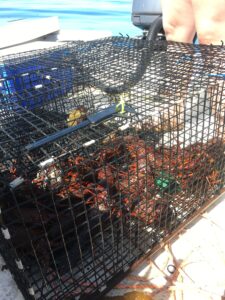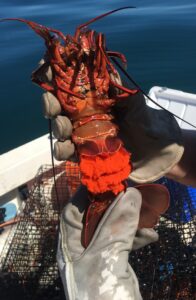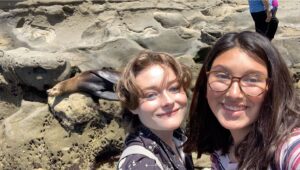Didi EarthTree, Marine Biology at CMIL, Week 1
Hello, my name is Didi and my internship is at the CMIL Marine Biology lab. I am working with lobsters and microorganisms. At the lab, we are studying the feeding patterns of the lobsters along with counting and identifying microorganisms in eelgrass. This lab is in San Diego, California, along the ocean shore.
To start off the week, Lulu and I went to the SDSU campus and cut small samples of lobster legs off. These were put into small capsules for another scientific team to look at. Vanessa helped us with this process. The project was looking at lobster distribution throughout the ocean and tracking how far lobsters disperse. Cutting a small part of the leg off, we put them into labeled capsules. Later in the week, Carle, who is another scientist at the lab, showed us how to sort microorganisms out of eelgrass. He was taking numerous samples of eelgrass, and measuring its length and how many microorganisms were in it. He did this to study its ecosystem and how much it varies from place to place. This was labeled a menial task for us and the other interns to do. This task is interesting though. Sorting the organisms and seeing that there can be up to 50 microorganisms in a small blade of grass shows how much life can be beneath the surface of something that you can’t see.
The most exciting day this week was when I and four other lab members embarked on a journey by boat to collect four lobster traps that had been put out days before. We rode on a boat for ten minutes, before finally seeing the small buoys above water, which were showing where the lobster traps were. Upon arriving at the spot Vanessa, (who I was mainly working with in the lab) showed me the giant sea kelp. This plant grows from the top, which means that it can reach more than 100 feet. This kelp quickly became more of a nuisance than beautiful when we had to cut it off of the lobster traps that needed to be hauled up from 30 feet. Once the traps were up though, it was amazing. With probably 20 lobsters in each trap, it took quite a while to sort and measure them. The woman who needed the lobsters for an experiment only wanted males of a certain length. The rest were thrown back into the ocean. In the trap, we found an assortment of captivating creatures, including a very large crab, and a moray eel. The most fascinating one, however, was a female lobster who was carrying eggs. We took a small sample of the eggs, then released her back into the ocean right away. Once we were back in the lab, Carol needed the endless micro organisms sorted from eelgrass, so I and the interns set to work on sorting.
In my personal life, Lulu and I went to La Jolla beach and saw several sea lions sunbathing. This was particularly interesting because we got to see several small crabs, sea cucumbers, and sea anemones. The sea cucumbers had been washed into a small tide pool and were holding onto tiny shell particles for protection. After viewing this, we got gelato at an ice cream store to finish off the day.




There are no comments published yet.